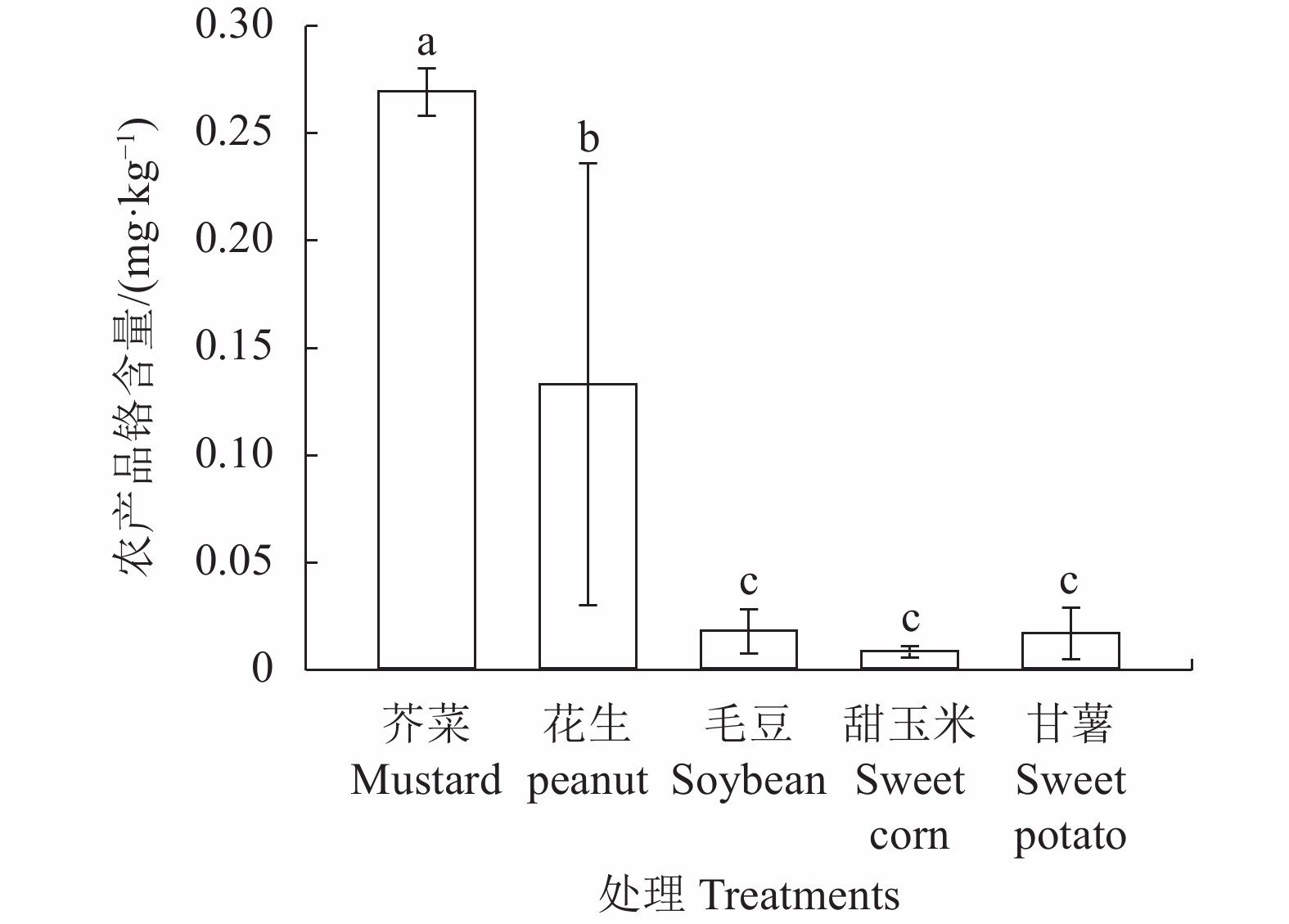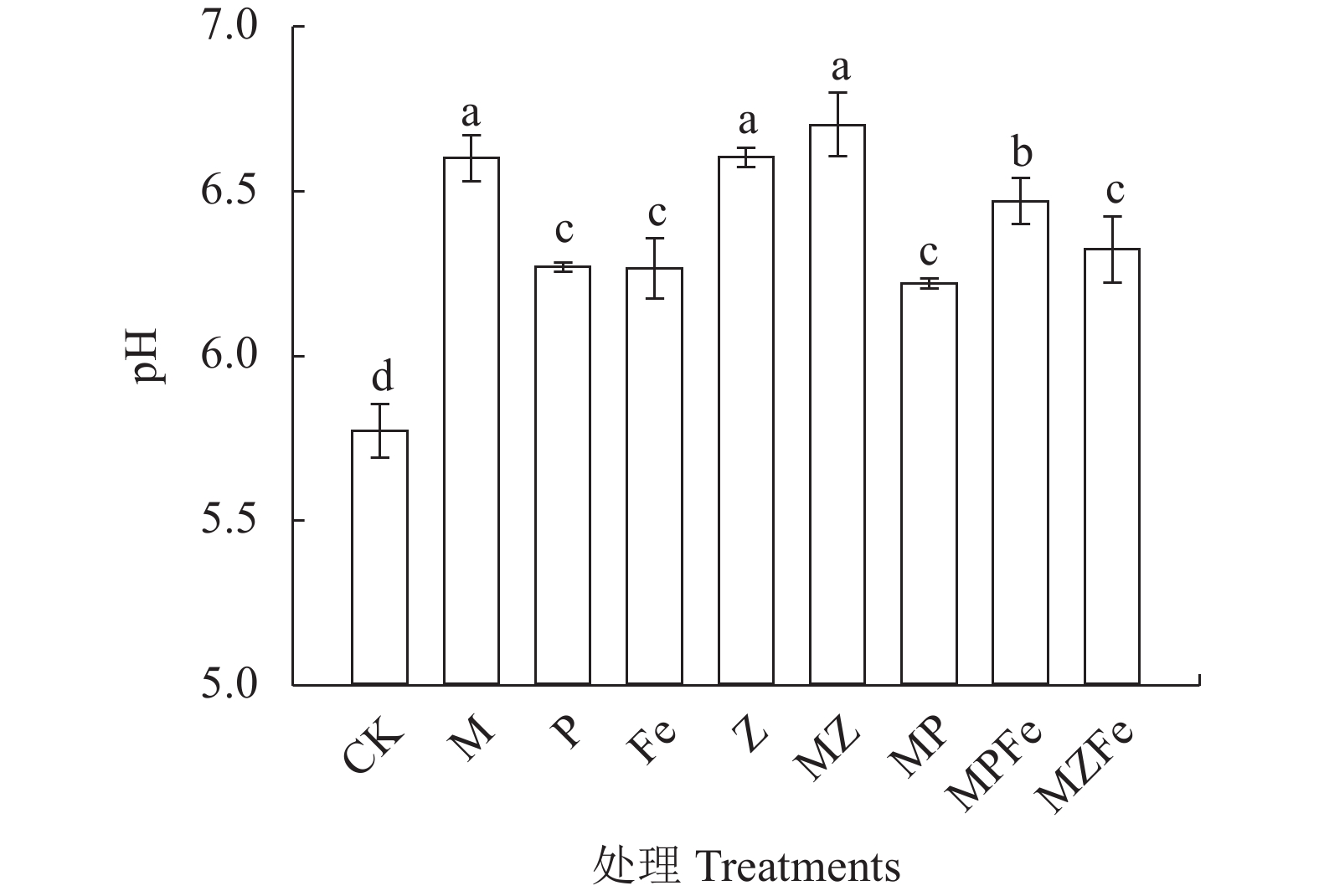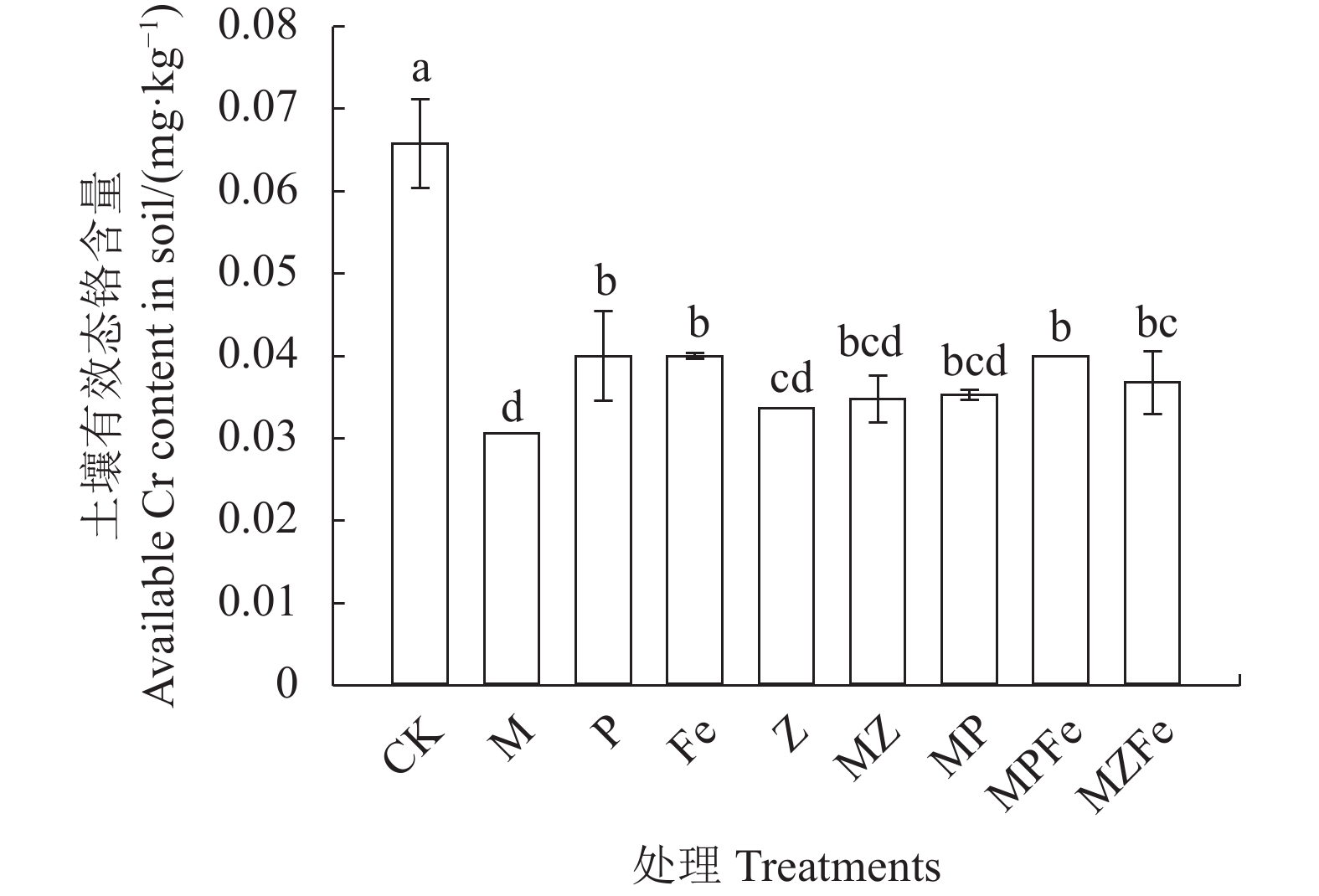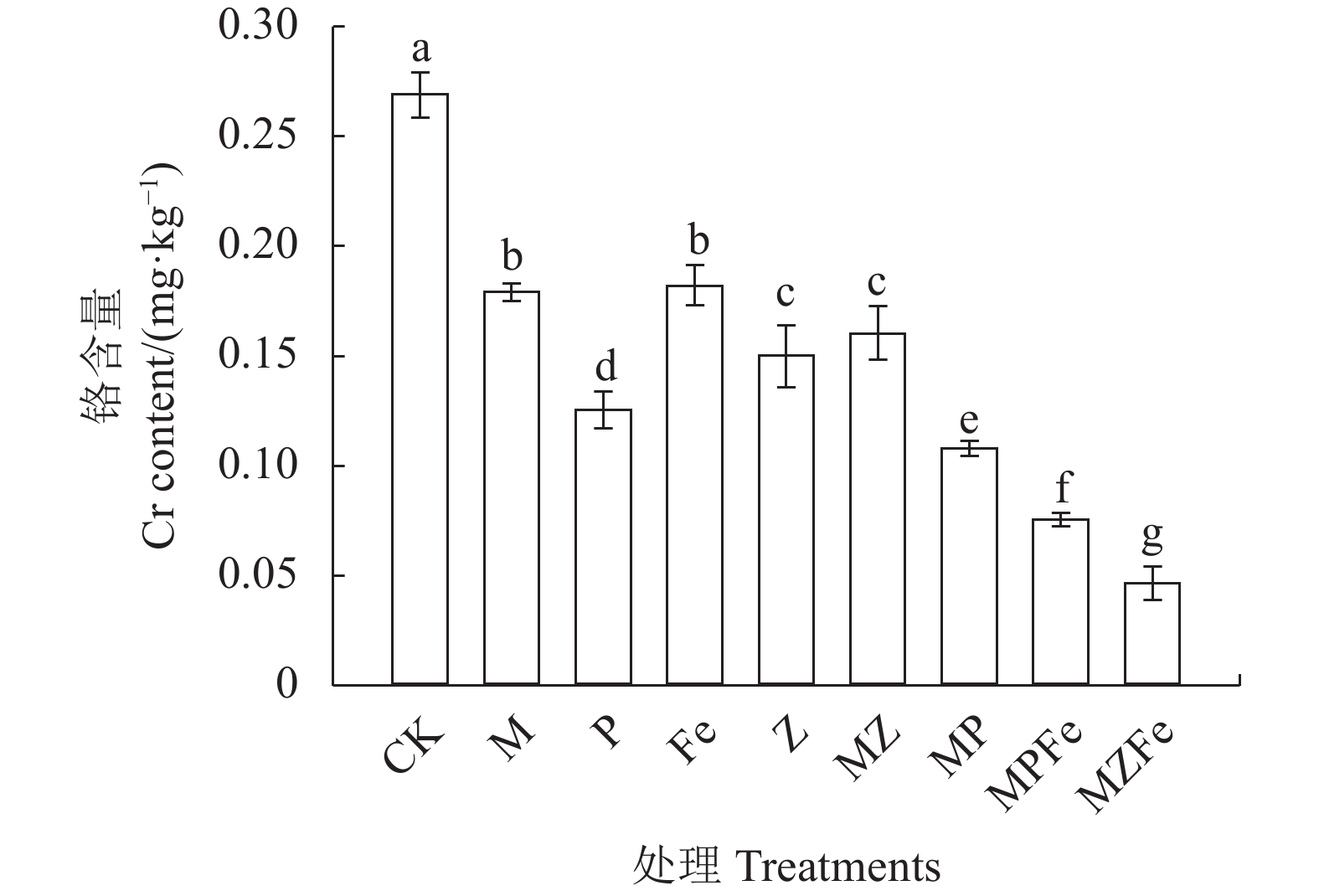Chromium Migration and Application of Conditioners in Vegetable-growing Soil
-
摘要:目的 探讨不同作物富集铬能力差异及施用不同类型调理剂对铬在土壤-芥菜系统迁移的影响。方法 选择铬轻度污染农田进行田间试验,研究皱叶芥菜(Brassica juncea L. Czern and Coss)、花生(Arachis hypogaea L.)、甜玉米(Zea mays L. var. rugosa Bonaf.)、甘薯(Ficus tikoua Bur)、和毛豆(Glycine max Merrill )5种作物铬的富集效果;然后根据试验结果,选择高富集作物(皱叶芥菜)作为研究对象,研究不同调理剂对铬富集土壤的修复效果。调理剂修复效果试验设置对照(CK)、泥炭土(P)、有机肥(M)、沸石(Z)、硫酸亚铁(Fe)、有机肥+泥炭土(MP,1:2)、有机肥+沸石(MZ,1:2)、有机肥+泥炭土+硫酸亚铁(MPFe,3:6:1)、有机肥+沸石+硫酸亚铁(MZFe,3:6:1)9个试验处理。其中,硫酸亚铁用量为540 kg·hm−2,其他调理剂用量为5400 kg·hm−2。结果 作物富集效果试验表明,5种作物铬含量均未超过国家限量标准,皱叶芥菜富集铬能力最高,甜玉米富集铬能力最低,皱叶芥菜和花生富集铬能力显著高于甜玉米、甘薯和毛豆。调理剂修复效果试验表明,调理剂施用显著提升了土壤pH,各调理剂处理土壤pH提升0.45~0.93个单位。除Z和Fe外,其他调理剂处理均显著提升了皱叶芥菜产量,增产率为5.66%~12.77%。调理剂还显著降低了土壤有效态铬含量,降幅达39.8%~53.8%。与对照相比,P、M、Z、Fe、MP、MZ、MPFe和MZFe分别将皱叶芥菜铬含量降低了53%、33%、44%、32%、59%、40%、72%、82%,均未超过国家限量标准。结论 皱叶芥菜铬富集能力显著高于花生、甜玉米、甘薯和毛豆;选择单施或复合施用有机肥、泥炭土、沸石及硫酸亚铁均可显著降低土壤有效性铬含量和皱叶芥菜中铬含量,其中,施用有机肥+泥炭土(沸石)+硫酸亚铁复合调理剂对皱叶芥菜降铬效果较好。Abstract:Objective Accumulation of chromium (Cr) in vegetables migrated from soil and mitigation effect of soil conditioner applications were investigated.Methods A field experimentation was conducted on a slightly polluted lot to determine the Cr-uptakes of green mustard (Brassica juncea L. Czern and Coss), peanut (Arachis hypogaea L.), sweet corn (Zea mays L. var. rugosa Bonaf.), sweet potato (Ficus tikoua Bur), and soybean (Glycine max Merrill) plants grown on it. Vegetable with the greatest Cr-uptake was further tested on the lot for the heavy metal accumulation under the soil treatments of blank (CK), peat (P), and addition of organic fertilizer (M), zeolite (Z), FeSO4 (Fe), M+P at 1∶2 (MP), M+Z at 1∶2 (MZ), M+P+FeSO4 at 3∶6∶1 (MPFe) or M+Z+FeSO4 at 3∶6∶1 (MZFe). The application of FeSO4 was at a rate of 540 kg·hm−2, and the others at 5400 kg·hm−2.Results None of the initial tested vegetables had a Cr content exceeded the national safety standard. Since the green mustard had the highest uptake rate, it was used in the subsequent experimentation. The various added conditioners raised the soil pH by 0.45-0.93; increased the yield of mustard by 5.66-12.77%, except Z and Fe; and decreased the available Cr in soil by 39.8-53.8%. The treatments of P, M, Z, Fe, MP, MZ, MPFe, and MZFe lowered Cr content in the mustard by 53%, 33%, 44%, 32%, 59%, 40%, 72%, and 82%, respectively.Conclusion The Cr-uptake of mustard was significantly higher than those of the other crops grown on the same field. Both available Cr in soil and in mustard were significantly reduced by the M, P, Z, and Fe treatments that applied soil conditioner singly or in combination. In combination, MPFe or MZFe performed significantly superior in reducing Cr-accumulation in mustard.
-
Keywords:
- Organic fertilizer /
- peat soil /
- zeolite /
- ferrous sulfate /
- chromium /
- mustard
-
0. 引言
【研究意义】秀珍菇学名肺形侧耳[Pleurotus pulmonarius(Fr.)Quél.],因朵型小巧,又名袖珍菇,是中温型结实食用菌[1]。秀珍菇不仅营养丰富,富含人体必需氨基酸、蛋白质等,风味独特[2-6],还具有抗氧化、抗肿瘤、降血压、降血糖和提高免疫力等功能[7-10]。与平菇(糙皮侧耳)相比,因采收时成熟度小,质地更为鲜嫩,口感更为滑嫩,深受消费者喜爱。木霉是秀珍菇栽培上的重要竞争性杂菌,其主要与秀珍菇菌丝竞争营养,由于木霉生长快,繁殖能力强,繁殖系数高,一旦出现,极易爆发,严重时导致大量菌包废弃,造成较大经济损失[11-12]。研究秀珍菇不同菌株适宜生长条件,阐明秀珍菇与木霉共培养特性,对秀珍菇栽培菌种的选择及温度管理具有重要指导意义。【前人研究进展】秀珍菇自1998年由我国台湾地区引入大陆,并在福建罗源试种150万袋获得成功后,在福建、浙江、河南、山东、安徽、江苏等地开始大面积栽培[13-16]。秀珍菇栽培地区和面积的增加也逐渐提高了产量,2019年全国秀珍菇产量超过30万t,较上一年增长20.27%[17]。目前我国虽然已认定了多个秀珍菇品种,但许多栽培者偏好于 “台秀”57菌株[18-19]。温度是食用菌正常生长的必要条件,主要影响食用菌菌丝的生长速度,以及子实体的分化数量和质量[20]。培养基质为食用菌的生长提供必需的营养物质,培养基质是否适宜决定了菌株菌丝和子实体的质量。秀珍菇常用PDA培养基培养,菌丝生长良好[21]。冯志勇等研究发现,秀珍菇菌丝生长的最适碳源、氮源组合是酵母粉和可溶性淀粉,菌丝粗壮,生长速度快[22]。【本研究切入点】采用传统方式栽培,秀珍菇菌性变化明显,在生产上易引起菌棒满菌后退菌、开袋出菇少,甚至不出菇、易感染霉菌等现象,导致秀珍菇栽培的不稳定性,使生产者遭受经济损失。2015–2018年全国秀珍菇产值曾一度下降[23]。据栽培者经验判断,产生这些问题的主要原因可能是菌种退化,导致秀珍菇菌种退化以及秀珍菇菌丝易受木霉病菌侵染的原因有待深入研究。【拟解决的关键问题】旨从温度和培养基质方面着手,观察秀珍菇菌丝在不同培养基和温度条件下,菌丝形态和生长情况。筛选出秀珍菇菌丝生长的适宜温度和培养基条件;探寻秀珍菇与木霉菌丝适宜生长的温度差异,为秀珍菇科学栽培提供理论支撑。
1. 材料与方法
1.1 试验材料
1.1.1 供试菌株
X98ly-13、Y710-14、Xd-13菌株保存于福建省农业科学院食用菌研究所,X903-1与X86-1是多孢分离获得的新材料,亲本分别为X903与X86。木霉菌株(T001)分离自秀珍菇菌包,并经形态学鉴定为哈茨木霉(Trichoderma harzianum)。
1.1.2 培养基配方
马铃薯琼脂葡萄糖培养基(PDA):马铃薯(200 g)、琼脂粉(20 g)、葡萄糖(20 g)、水(1 000 mL)。马铃薯琼脂葡萄糖+淀粉培养基(PDSA):马铃薯(200 g)、琼脂粉(20 g)、葡萄糖(20 g)、可溶性淀粉(5 g)、水(1 000 mL)。 马铃薯琼脂葡萄糖+酵母培养基(PDYA):马铃薯(200 g)、琼脂粉(20 g)、葡萄糖(20 g)、酵母粉(5 g)、水(1 000 mL)。马铃薯琼脂葡萄糖+淀粉+酵母培养基(PDSYA):马铃薯(200 g)、琼脂粉(20 g)、葡萄糖(20 g)、酵母粉(2.5 g)、可溶性淀粉(2.5 g)、水(1 000 mL)。
1.2 试验方法
1.2.1 不同温度对秀珍菇和木霉菌丝生长的影响
将秀珍菇和木霉菌丝块接种在PDA培养基质中,分别放在不同温度条件(25、28、30、32、34、36 ℃)的培养箱中,记录萌发时间,平板菌丝生长速度以平板中菌落半径日增长量计算。
1.2.2 PDA与半合成培养基对秀珍菇菌丝生长的影响
将秀珍菇菌株分别接种在PDA、PDSA、PDYA和PDSYA培养基,记录萌发时间,菌丝生长速度以平板中菌落半径日增长直径计算。
1.2.3 秀珍菇与木霉共培养
将秀珍菇和木霉菌块分别接在距培养皿边缘2 cm的两端 ,每个处理重复3次,标上菌株号,在不同温度的恒温箱中培养,定期观察。
1.3 数据分析
通过Excel 2007和DPS 7.05,对数据进行记录和差异显著性分析。
2. 结果与分析
2.1 温度对秀珍菇菌丝生长及与木霉共培养的影响
秀珍菇菌株在不同温度条件下的生长速度情况见表1。5个菌株在25、28、30 ℃萌发时间均为24 h。当温度超过30 ℃,随着温度逐渐升高,萌发时间逐渐加长。34 ℃ 5个菌株的萌发时间均为72 h以上。X98ly-13、Xd-13、903-1、86-1等4个菌株在25、28、30 ℃菌丝生长速度无显著性差异,但与30和32 ℃有极显著差异。Y710-14菌株菌丝生长最快的温度为30 ℃,与其他4个温度有极显著差异。从满皿时间来看,菌丝最快满皿的菌株为Xd-13,在25、28 ℃,均为5 d。Y710-14、Xd-13菌丝在30 ℃,均为5.33 d。86-1菌株菌丝生长最慢,在32、34 ℃,满皿时间均超过20 d。36 ℃时,秀珍菇菌丝长期处于萌发状态,生长非常缓慢。
表 1 温度对秀珍菇菌丝生长速度的影响Table 1. Effects of temperature on mycelial growth of P. pulmonarius菌株
Strain温度
Temperature/
℃萌发时间
Germination
time/h菌丝生长速度
The growth rate of
mycelia
/(mm·d−1)满皿时间
Full petri
dish time/dX98ly-13 25 24 8.63±0.01 Aa 6 28 24 8.25±0.01 Aab 6 30 24 7.96±0.05 ABbc 6 32 24 7.50±0.01 Bc 6.33 34 72 0.92±0.02 Cd >15 Y710-14 25 24 7.42±0.06 Bc 6.67 28 24 8.00±0.03 Bb 6 30 24 8.83±0.01 Aa 5.33 32 24~48 6.46±0.01 Cd 8.33 34 72 0.83±0.03 De >15 Xd-13 25 24 8.88±0.02 Aa 5 28 24 7.63±0.01 Aa 5 30 24 8.38±0.03 ABb 5.33 32 24~48 7.75±0.03 Bc 6.67 34 72 0.92±0.01 Cd >15 903-1 25 24 7.86±0.08 Aa 6 28 24 7.71±0.01 Aa 6 30 24 7.71±0.02 Aa 6 32 24~48 6.29±0.06 Bb 7.67 34 72 0.67±0.01 Cc >15 86-1 25 24 5.38±0.04 Aa 9 28 24 4.46±0.09 ABa 10 30 24 4.38±0.09 ABa 11.33 32 24~48 3.08±0.05 Bb 20.33 34 72 0.46±0.01 Cc >21 注:表中不同大小写字母表示同一菌株在不同温度条件下菌丝生长速度有极显著差异(P<0.01)和显著差异(P<0.05)。
Note: Data with different uppercase and lowercase letters on same column indicate significant differences at P<0.01 and P<0.05, respectively.试验结果表明,木霉在不同温度下菌丝的生长速度有差异(表2)。6种温度条件,25~32 ℃,木霉菌丝生长势旺盛,其中28 ℃木霉菌丝生长最快,约2 d长满90 mm培养皿,随着温度升高,菌丝生长速度变慢,34 ℃,木霉菌丝生长速度明显减弱,约3 d长满90 mm培养皿。36 ℃,木霉菌丝生长非常缓慢,菌丝泛黄,生长势最弱。同时测定了Xd-13菌丝、木霉菌丝在不同温度下的生长情况及秀珍菇菌丝与木霉菌丝的共培养情况(图1)。结果表明,在相同条件下,木霉菌丝的生长速度与秀珍菇菌丝的生长速度有极显著差异,秀珍菇菌丝的生长速度明显慢于木霉菌丝,且秀珍菇菌丝对木霉菌丝无拮抗现象,秀珍菇菌丝很快被完全覆盖,失去竞争力。
表 2 木霉在不同温度条件下菌丝生长情况Table 2. Mycelial growth of T. harzianum at different temperatures温度
Temperature/
℃萌发时间
Germination
time/h菌丝生长速度
Growth rate of mycelia/
(mm·d−1)满皿
时间
Full petri
dish time/d覆盖秀珍菇
菌丝时间
Infect mycelia of
Pleurotus
pulmonarius
time/h25 <24 19.33±0.03 Bb 2.21 48 28 <24 20.5±0.05 Aa 2.21 48 30 <24 19.33±0.03 Bb 2.5 48 32 24 18.5±0.05 Bc 3 48~54 34 24~48 14.67±0.03 Cd 3 54~72 36 72 3.17±0.03 De / / 注:表中不同大小写字母表示菌株在不同温度条件下菌丝生长速度有极显著差异(P<0.01)和显著差异(P<0.05)。
Note: Data with different uppercase and lowercase letters on same column indicate significant differences at P<0.01 and P<0.05, respectively.![]() 图 1 秀珍菇(XD-13)木霉(T001)菌丝在不同温度条件下生长及共培养情况注:①A:秀珍菇菌丝;B:木霉菌丝;C:秀珍菇和木霉菌丝共培养;②图中平皿从左到右处理温度依次为25、28、32 ℃(上排),34、36 ℃(下排)。Figure 1. Mycelial growth of P. pulmonarius (XD-13) and T. harzianum (T001) in cocultivation at different temperaturesNote: ① A: mycelia of P. pulmonarius; B: mycelia of T. harzianum; C: mycelia of P. pulmonarius and T. harzianum. ② Plate temperatures from left to right at 25 ℃, 28 ℃, and 32 ℃ on upper row; 34 ℃ and 36 ℃ on bottom row.
图 1 秀珍菇(XD-13)木霉(T001)菌丝在不同温度条件下生长及共培养情况注:①A:秀珍菇菌丝;B:木霉菌丝;C:秀珍菇和木霉菌丝共培养;②图中平皿从左到右处理温度依次为25、28、32 ℃(上排),34、36 ℃(下排)。Figure 1. Mycelial growth of P. pulmonarius (XD-13) and T. harzianum (T001) in cocultivation at different temperaturesNote: ① A: mycelia of P. pulmonarius; B: mycelia of T. harzianum; C: mycelia of P. pulmonarius and T. harzianum. ② Plate temperatures from left to right at 25 ℃, 28 ℃, and 32 ℃ on upper row; 34 ℃ and 36 ℃ on bottom row.2.2 培养基对秀珍菇菌丝生长的影响
温度为25 ℃时,5个秀珍菇菌株在四种培养基上的生长速度均无显著性差异,萌发时间均为24 h,生长情况见图2。X98ly-13菌株在PDYA培养基中的生长速度稍快于PDSYA培养基,在PDSA培养基中菌丝生长速度最慢。添加淀粉或酵母粉的培养基均可促进Y710-14、Xd-13和903-1菌株菌丝的生长,其中PDYA培养基对Y710-14菌丝日生长速度最快,PDSA培养基对Xd-13菌丝生长促进作用最明显,PDSYA培养基对903-1菌株菌丝的促进作用最大。5个秀珍菇菌株在PDYA培养基中的生长势最强,其次为PDSYA培养基,PDSA和PDA培养基中的菌丝生长势正常。加淀粉时秀珍菇菌丝普遍比正常菌丝更白,呈现乳白色。
![]() 图 2 5个菌株在不同培养基条件下菌丝的生长情况注:①A:X98ly-13菌株;B:Y710-14菌株;C:XD-13菌株;D:903-1菌株;E:86-1菌株。②平皿从左至右依次为PDA、PDSA、PDYA、PDSYA培养基。Figure 2. Mycelial growth of 5 strains of P. pulmonarius cultured on different mediaNote: ①A:X98ly-13; B: Y710-14; C: XD-13; D: 903-1; E: 86-1. ② Plates from left to right represent culture media PDA, PDSA, PDYA, and PDSYA.
图 2 5个菌株在不同培养基条件下菌丝的生长情况注:①A:X98ly-13菌株;B:Y710-14菌株;C:XD-13菌株;D:903-1菌株;E:86-1菌株。②平皿从左至右依次为PDA、PDSA、PDYA、PDSYA培养基。Figure 2. Mycelial growth of 5 strains of P. pulmonarius cultured on different mediaNote: ①A:X98ly-13; B: Y710-14; C: XD-13; D: 903-1; E: 86-1. ② Plates from left to right represent culture media PDA, PDSA, PDYA, and PDSYA.25 ℃条件下,秀珍菇不同菌株在4种培养基中菌丝的生长速度情况如表3所示,Xd-13菌丝生长速度均最快;86-1菌株生长速度最慢,与其他4个菌株的菌丝生长速度有极显著差异。PDSA培养基条件下,Y710-14菌株菌丝生长速度与Xd-13和X98ly-13无显著性差异,与903-1菌株有极显著差异。PDA和PDSYA培养基条件下,X98ly-13菌株菌丝的生长速度稍快于Y710-14菌株,PDSA和PDYA培养基条件下,X98ly-13菌株菌丝的生长速度稍慢于 Y710-14菌株,但它们之间均无显著性差异。
表 3 秀珍菇不同菌株在4种培养基中的菌丝生长情况分析Table 3. Mycelial growth of 5 strains of P. pulmonarius on 4 different culture media培养基
Culture
medium菌株
Strain菌丝生长速度
The growth rate
of mycelia/
(mm·d−1)菌丝特征
Mycelia characteristicsPDA X98ly-13 8.42±0.38 Aa 生长速度快、粗壮浓密、洁白 Y710-14 8.05±1.04 Aa 生长速度较快、浓密、洁白 XD-13 8.67±0.90 Aa 生长速度快、气生菌丝多、洁白 903-1 7.72±0.36 Aa 生长速度中等、较密、洁白 86-1 6.06±0.88 Bb 生长速度慢、粗壮浓密、洁白 PDSA X98ly-13 7.78±1.20 Bb 生长速度快、粗壮浓密、乳白 Y710-14 8.44±0.46 ABab 生长速度快、浓密、乳白 XD-13 9.28±0.51 Aa 生长速度快、气生菌丝多、乳白 903-1 7.56±0.58 Bb 生长速度中等、较密、乳白 86-1 6.00±0.56 Cc 生长速度慢、粗壮浓密、乳白 PDYA X98ly-13 8.58±0.66 Aab 生长速度快、粗壮浓密、洁白 Y710-14 8.78±0.75 Aa 生长速度快、浓密、洁白 XD-13 8.89±0.82 Aa 生长速度快、气生菌丝多、洁白 903-1 7.83±0.35 Ab 生长速度正常、较密、洁白 86-1 6.22±0.62 Bc 生长速度慢、粗壮浓密、洁白 PDSYA X98ly-13 8.22±0.71 Aa 生长速度快、粗壮浓密、洁白 Y710-14 8.11±0.49 Aa 生长速度快、浓密、洁白 XD-13 8.75±0.69 Aa 生长速度快、气生菌丝多、洁白 903-1 8.05±0.81 Aa 生长速度正常、较密、洁白 86-1 6.72±0.36 Bb 生长速度慢、粗壮浓密、洁白 注:表中不同大、小写字母表示不同菌株在相同培养基条件下菌丝生长速度有极显著差异(P<0.01)和显著差异(P<0.05)。
Note: Means within a column followed by different uppercase and lowercase letters indicate significant difference at P<0.01 or P<0.05, respectively.3. 讨论与结论
不同温度对5种秀珍菇菌株的菌丝生长均有不同程度的影响,同一温度条件,不同菌株生长速度有差异。其中4个菌株菌丝适宜生长温度范围均为25~30 ℃,在此温度范围菌丝生长速度无显著性差异,但与32 ℃和34 ℃条件有极显著差异,最适生长温度为25 ℃,这与王再明等的研究结果一致[19, 20],Y710-14菌株菌丝最适生长温度为30 ℃。试验结果表明,5个菌株在32 ℃,菌丝生长速度变慢,34 ℃秀珍菇菌丝生长非常缓慢。可见,秀珍菇菌株菌丝正常生长的临界温度介于32~34 ℃。这为秀珍菇生产上菌包包心温度的控制提供重要参考。Y710-14菌株菌丝最适生长温度较高,推断其应为中温偏高型菌株。秀珍菇常规栽培的品种为中温型菌株,为适应夏季规模化生产,雷潇等筛选了适宜湖南夏季设施化栽培的秀珍菇优良菌株26和秀58高温品种[24]。可见,不同秀珍菇菌株菌丝生长对温度要求有差异,温度是影响秀珍菇菌丝生长的重要因子,在生产上应根据地区气候条件和种植模式情况,选择适宜的秀珍菇菌株。秀珍菇菌丝生长速度的快慢除了与温度有关,可能还与菌株自身特性有关系,菌株菌丝生长速度快慢是否影响栽培出菇的产量与品质,有待更进一步探究。
吴小平等曾通过PDA平板筛选,发现香菇(Lentinula edodes)、鲍鱼菇(Pleurotus cystidiosus)和杏鲍菇(Pleurotus cryngi)等食用菌菌丝对木霉都没有抗性,但发现秀珍菇部分菌株对木霉有抗性[25]。本试验结果表明秀珍菇(XD-13)菌丝对木霉(T001)无拮抗作用。由此推断,在生产中遇上高温高湿天气,菇房、菌包中潜在的木霉病菌大量快速繁殖,当菌包温度介于32~34 ℃,秀珍菇菌丝与木霉菌丝之间的生长势相差更大,秀珍菇菌丝很快就失去竞争力,于是出现“绿包”现象,造成经济损失。要想避免秀珍菇生产过程中“绿包”现象的发生,首先菌包灭菌要彻底,保持菇房环境整洁卫生,其次可筛选出对木霉有抗性的秀珍菇新品种。
半合成培养基培养试验表明,秀珍菇同一菌株在3种添加淀粉或酵母粉的不同培养基上生长速度与对照PDA培养基无显著性差异。但添加酵母粉及酵母粉与淀粉组合的培养基,菌丝的生长势明显增强,菌丝更浓密,这与冯志勇等的研究结果一致[22],且添加淀粉培养基的菌丝普遍比正常菌丝白,呈现乳白色。有关营养物质的添加浓度,经添加营养物质培养的秀珍菇菌株活力是否更强,保藏时间是否更长,在栽培出菇阶段产量和品质表现等,有待深入研究。
-
表 1 土壤和调理剂基本理化性质
Table 1 Physiochemical properties of soil and conditioners
土壤和调理剂
Soil and conditionerspH 有机质
Organic matter/
(g·kg−1)阳离子交换量
Cation exchange capacity/
(cmol·kg−1)机械组成
Mechanical composition/
%重金属含量
Total amount of heavy Metals/
(mg·kg−1)砂粒
Sand粉粒
Silt黏粒
Clay镉
Cd铅
Pb砷
As汞
Hg铬
Cr土壤 Soil 6.63 16.30 39.93 29.5 28.5 42.0 0.15 13 1.58 0.074 203 沸石 Zeolite 6.02 — — — — — ND 15 8.52 0.060 30 有机肥 Organic fertilizer 8.55 51.8 — — — — 0.62 16.4 2.05 0.200 25 泥炭土 Peat soil 7.90 540 — — — — 0.595 154 14.3 0.034 54 ND:未检出。砂粒(2~0.02 mm),粉粒(0.02~0.002 mm),黏粒(<0.002 mm)。
Sand (2-0.02 mm); silt (0.02-0.002 mm); clay (<0.002 mm). -
[1] NAKKEERAN E, PATRA C, SHAHNAZ T, et al. Continuous biosorption assessment for the removal of hexavalent chromium from aqueous solutions using Strychnos nux vomica fruit shell [J]. Bioresource Technology Reports, 2018, 3: 256−260. DOI: 10.1016/j.biteb.2018.09.001
[2] LIAN G Q, WANG B, LEE X Q, et al. Enhanced removal of hexavalent chromium by engineered biochar composite fabricated from phosphogypsum and distillers grains [J]. Science of the Total Environment, 2019, 697: 134119. DOI: 10.1016/j.scitotenv.2019.134119
[3] 环境保护部, 国土资源部. 全国土壤污染状况调查公报[R]. 北京: 环境保护部, 国土资源部, 2014. [4] 赵方杰, 谢婉滢, 汪鹏. 土壤与人体健康 [J]. 土壤学报, 2020, 57(1):1−11. ZHAO F J, XIE W Y, WANG P. Soil and human health [J]. Acta Pedologica Sinica, 2020, 57(1): 1−11.(in Chinese)
[5] 张桃林. 守护耕地土壤健康 支撑农业高质量发展 [J]. 土壤, 2021, 53(1):1−4. ZHANG T L. Protecting soil health of cultivated land to promote high-quality development of agriculture in China [J]. Soils, 2021, 53(1): 1−4.(in Chinese)
[6] 孙志佳, 李保飞, 陈玉海, 等. 湛江东北部农用地土壤重金属污染及生态风险评价 [J]. 河北农业大学学报, 2022, 45(1):61−68. SUN Z J, LI B F, CHEN Y H, et al. Assessment of agricultural land on soil heavy metals pollution and ecological risk in the northeast of Zhanjiang City [J]. Journal of Hebei Agricultural University, 2022, 45(1): 61−68.(in Chinese)
[7] ROMERO-ESTÉVEZ D, YÁNEZ-JÁCOME G S, NAVARRETE H. Non-essential metal contamination in Ecuadorian agricultural production: A critical review [J]. Journal of Food Composition and Analysis, 2023, 115: 104932. DOI: 10.1016/j.jfca.2022.104932
[8] DESMARIAS T L, COSTA M. Mechanisms of chromium-induced toxicity [J]. Current Opinion in Toxicology, 2019, 14: 1−7. DOI: 10.1016/j.cotox.2019.05.003
[9] ERTANI A, MIETTO A, BORIN M, et al. Chromium in agricultural soils and crops: A review [J]. Water, Air, & Soil Pollution, 2017, 228(5): 190.
[10] 王成文, 许模, 张俊杰, 等. 土壤pH和Eh对重金属铬(Ⅵ)纵向迁移及转化的影响 [J]. 环境工程学报, 2016, 10(10):6035−6041. DOI: 10.12030/j.cjee.201505010 WANG C W, XU M, ZHANG J J, et al. Influence of soils pH and Eh on vertical migration and transformation of Cr(Ⅵ) [J]. Chinese Journal of Environmental Engineering, 2016, 10(10): 6035−6041.(in Chinese) DOI: 10.12030/j.cjee.201505010
[11] RAPTIS S, GASPARATOS D, ECONOMOU-ELIOPOULOS M, et al. Chromium uptake by lettuce as affected by the application of organic matter and Cr(VI)-irrigation water: Implications to the land use and water management [J]. Chemosphere, 2018, 210: 597−606. DOI: 10.1016/j.chemosphere.2018.07.046
[12] CHOPPALA G, KUNHIKRISHNAN A, SESHADRI B, et al. Comparative sorption of chromium species as influenced by pH, surface charge and organic matter content in contaminated soils [J]. Journal of Geochemical Exploration, 2018, 184: 255−260. DOI: 10.1016/j.gexplo.2016.07.012
[13] XIAO W D, YE X Z, ZHU Z Q, et al. Continuous flooding stimulates root iron plaque formation and reduces chromium accumulation in rice (Oryza sativa L. ) [J]. Science of the Total Environment, 2021, 788: 147786. DOI: 10.1016/j.scitotenv.2021.147786
[14] XIAO W D, YE X Z, ZHU Z Q, et al. Combined effects of rice straw-derived biochar and water management on transformation of chromium and its uptake by rice in contaminated soils [J]. Ecotoxicology and Environmental Safety, 2021, 208: 111506. DOI: 10.1016/j.ecoenv.2020.111506
[15] 罗泉达. 三种肥料对巨菌草修复镉污染土壤的效果研究 [J]. 福建农业学报, 2022, 37(3):398−404. LUO Q D. Fertilizer-enhanced phytoextraction of Pennisetum sinese roxb on cadmium in soil [J]. Fujian Journal of Agricultural Sciences, 2022, 37(3): 398−404.(in Chinese)
[16] 徐榕, 王华伟, 孙英杰, 等. 沼渣协同硫酸亚铁修复Cr(Ⅵ)污染土壤 [J]. 环境科学学报, 2021, 41(10):4161−4169. XU R, WANG H W, SUN Y J, et al. Remediation of Cr(Ⅵ) from contaminated soil with the combination of biogas residue and ferrous sulfate [J]. Acta Scientiae Circumstantiae, 2021, 41(10): 4161−4169.(in Chinese)
[17] 李顺江, 李鹏, 李新荣, 等. 不同肥源、施氮量对土壤-作物系统中铬、镉含量的影响 [J]. 农业资源与环境学报, 2015, 32(3):235−241. LI S J, LI P, LI X R, et al. The influence of concentration of chromium, cadmium in soil-crop system under different fertilizers and fertilization amount [J]. Journal of Agricultural Resources and Environment, 2015, 32(3): 235−241.(in Chinese)
[18] 宁川川, 王建武, 蔡昆争. 有机肥对土壤肥力和土壤环境质量的影响研究进展 [J]. 生态环境学报, 2016, 25(1):175−181. NING C C, WANG J W, CAI K Z. The effects of organic fertilizers on soil fertility and soil environmental quality: A review [J]. Ecology and Environmental Sciences, 2016, 25(1): 175−181.(in Chinese)
[19] 孙莹, 侯玮, 迟美静, 等. 氮肥与有机肥配施对设施土壤腐殖质组分的影响 [J]. 土壤学报, 2019, 56(4):940−952. DOI: 10.11766/trxb201807270342 SUN Y, HOU W, CHI M J, et al. Effect of combined application of nitrogen fertilizer and organic manure on soil humus composition in greenhouse [J]. Acta Pedologica Sinica, 2019, 56(4): 940−952.(in Chinese) DOI: 10.11766/trxb201807270342
[20] JIANG W J, CAI Q A, XU W, et al. Cr(VI) adsorption and reduction by humic acid coated on magnetite [J]. Environmental Science & Technology, 2014, 48(14): 8078−8085.
[21] CHWASTOWSKI J, STAROŃ P, KOŁOCZEK H, et al. Adsorption of hexavalent chromium from aqueous solutions using Canadian peat and coconut fiber [J]. Journal of Molecular Liquids, 2017, 248: 981−989. DOI: 10.1016/j.molliq.2017.10.152
[22] YANG S, CHENG Y, ZOU H, et al. Synergistic roles of montmorillonite and organic matter in reducing bioavailable state of chromium in tannery sludge [J]. Environmental Science and Pollution Research, 2022, 29(58): 87298−87309. DOI: 10.1007/s11356-022-21897-1
[23] SHI W Y, SHAO H B, LI H, et al. Progress in the remediation of hazardous heavy metal-polluted soils by natural zeolite [J]. Journal of Hazardous Materials, 2009, 170(1): 1−6. DOI: 10.1016/j.jhazmat.2009.04.097
[24] 李喜林, 仝重凯, 刘玲, 等. 粉煤灰合成沸石对铬污染土壤中Cr(Ⅲ)的吸附稳定化效果及机制研究 [J]. 安全与环境学报, 2021, 21(3):1240−1248. LI X L, TONG Z K, LIU L, et al. Study on the stabilization effect and mechanism of the synthesized zeolite from fly ash on Cr (Ⅲ) in chromium contaminated soil [J]. Journal of Safety and Environment, 2021, 21(3): 1240−1248.(in Chinese)
[25] 文叶轩, 郝硕硕, 朱家亮, 等. 天然和改性沸石对铬吸附特征研究 [J]. 中国陶瓷, 2015, 51(7):16−20. WEN Y X, HAO S S, ZHU J L, et al. Research on adsorption characteristics of chromium on natural and modified zeolite [J]. China Ceramics, 2015, 51(7): 16−20.(in Chinese)
[26] 孙星星, 朱靖, 陶润萍, 等. 外源铁对水稻累积土壤镉的影响 [J]. 扬州大学学报(自然科学版), 2022, 25(1):74−78. SUN X X, ZHU J, TAO R P, et al. Effect of exogenous iron on soil Cd accumulation of rice [J]. Journal of Yangzhou University (Natural Science Edition), 2022, 25(1): 74−78.(in Chinese)
[27] GRAHAM A M, BOUWER E J. Rates of hexavalent chromium reduction in anoxic estuarine sediments: PH effects and the role of acid volatile sulfides [J]. Environmental Science & Technology, 2010, 44(1): 136−142.
[28] OLAZABAL M A, NIKOLAIDIS N P, SUIB S A, et al. Precipitation equilibria of the chromium(VI)/iron(III) system and spectrospcopic characterization of the precipitates [J]. Environmental Science & Technology, 1997, 31(10): 2898−2902.
[29] ZHAO X L, SU Y C, LI S B, et al. A green method to synthesize flowerlike Fe(OH)3 microspheres for enhanced adsorption performance toward organic and heavy metal pollutants [J]. Journal of Environmental Sciences, 2018, 73: 47−57. DOI: 10.1016/j.jes.2018.01.010
[30] XU B, WANG F, ZHANG Q H, et al. Influence of iron plaque on the uptake and accumulation of chromium by rice (Oryza sativa L. ) seedlings: Insights from hydroponic and soil cultivation [J]. Ecotoxicology and Environmental Safety, 2018, 162: 51−58. DOI: 10.1016/j.ecoenv.2018.06.063
[31] LIU D H, ZOU J H, WANG M, et al. Hexavalent chromium uptake and its effects on mineral uptake, antioxidant defence system and photosynthesis in Amaranthus viridis L [J]. Bioresource Technology, 2008, 99(7): 2628−2636. DOI: 10.1016/j.biortech.2007.04.045
[32] RIZWAN M, ALI S, QAYYUM M F, et al. Mechanisms of biochar-mediated alleviation of toxicity of trace elements in plants: A critical review [J]. Environmental Science and Pollution Research, 2016, 23(3): 2230−2248. DOI: 10.1007/s11356-015-5697-7
[33] WU J Q, SHA C Y, WANG M, et al. Effect of organic fertilizer on soil bacteria in maize fields [J]. Land, 2021, 10(3): 328. DOI: 10.3390/land10030328
[34] WYSZKOWSKA J, BOROWIK A, ZABOROWSKA M, et al. Sensitivity of Zea mays and soil microorganisms to the toxic effect of chromium (VI) [J]. International Journal of Molecular Sciences, 2022, 24(1): 178. DOI: 10.3390/ijms24010178
[35] TANG X, HUANG Y, LI Y, et al. Study on detoxification and removal mechanisms of hexavalent chromium by microorganisms [J]. Ecotoxicology and Environmental Safety, 2021, 208: 111699. DOI: 10.1016/j.ecoenv.2020.111699
[36] ANTONIADIS V, ZANNI A A, LEVIZOU E, et al. Modulation of hexavalent chromium toxicity on Οriganum vulgare in an acidic soil amended with peat, lime, and zeolite [J]. Chemosphere, 2018, 195: 291−300. DOI: 10.1016/j.chemosphere.2017.12.069
[37] ZHOU J M, CHEN H L, TAO Y L, et al. Biochar amendment of chromium-polluted paddy soil suppresses greenhouse gas emissions and decreases chromium uptake by rice grain [J]. Journal of Soils and Sediments, 2019, 19(4): 1756−1766. DOI: 10.1007/s11368-018-2170-5
[38] LEYVA-RAMOS R, JACOBO-AZUARA A, DIAZ-FLORES P E, et al. Adsorption of chromium(VI) from an aqueous solution on a surfactant-modified zeolite [J]. Colloids and Surfaces A:Physicochemical and Engineering Aspects, 2008, 330(1): 35−41.
[39] RADZIEMSKA M, WYSZKOWSKI M, BĘŚ A, et al. The applicability of compost, zeolite and calcium oxide in assisted remediation of acidic soil contaminated with Cr(III) and Cr(VI) [J]. Environmental Science and Pollution Research, 2019, 26(21): 21351−21362. DOI: 10.1007/s11356-019-05221-y
[40] RADZIEMSKA M, WYSZKOWSKI M. Using compost, zeolite and calcium oxide to limit the effect of chromium (III) and (VI) on the content of trace elements in plants [J]. Acta Universitatis Agriculturae et Silviculturae Mendelianae Brunensis, 2017, 65(2): 709−719. DOI: 10.11118/actaun201765020709
-
期刊类型引用(3)
1. 卯明娟,刘迪,周会明,白玉英,洪鹏,王佳琳,杨流波,陈真敏. 基于高产胞外粗多糖的白灵芝发酵茶培养基配方优化. 食品工业科技. 2024(04): 93-100 .  百度学术
百度学术
2. 闫静,王伟科,陆娜,宋吉玲,周祖法. 利用孢子紫外诱变选育秀珍菇新菌株. 中国食用菌. 2024(02): 38-45 .  百度学术
百度学术
3. 胡佳,陈鑫. 高温天气因素对杏鲍菇不同生长阶段的影响. 中国农学通报. 2024(36): 57-62 .  百度学术
百度学术
其他类型引用(0)




 下载:
下载:







